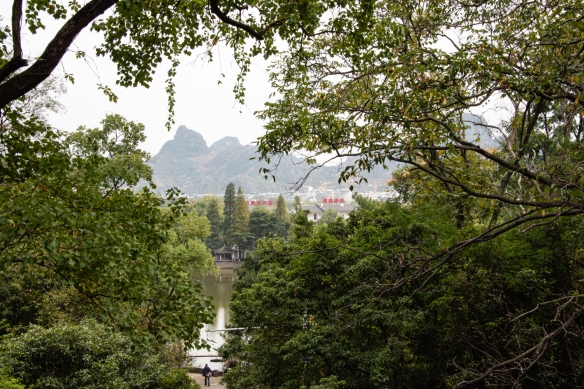
The setting for Reed Flute Cave (Ludi Yan) along Peach Blossom River, about 5 kilometers (3 miles) northwest of downtown Guilin, Guangxi, China
From the ship, a we joined a small group of fellow Residents for a four-day overland trip to the south-central province of Guangxi (located on the border of Vietnam), more properly called the Guangxi Zhuang Autonomous Region. We had an early morning flight from Shanghai to Guilin, where we were met by a local guide who escorted us to a nice Chinese lunch downtown in the city of 4.75 million. After lunch we were driven northwest of downtown Guilin about 5 kilometers (3 miles) to the Reed Flute Cave complex (Ludi Yan) where we had an extensive walking tour through the cave, estimated to be around 700,000 years old, having been forming for an estimated 180 million year. The cave is also known as “the Palace of Natural Arts”.
“Guilin has long been an important centre of trade and administration because of its location on an agriculturally rich valley floor that is also the easiest route south from Hunan. In 1939 the Hunan-Guangxi railway was extended through Guilin to Liuzhou via this corridor.
“Guilin has always been a handicraft centre, but until 1949 the only signs of modern industry were a thermal power plant, a cement works, and some small textile mills. Since the 1950s Guilin has developed industries engaged in the manufacture of electronics, engineering and agricultural equipment, medicine, rubber, and buses, and it also has textile and cotton yarn factories. Food processing, including the processing of local agricultural produce, remains the most important industry.
Guilin is also a cultural centre. As a major centre of Buddhism in the 7th century, it had many famous monasteries. Today the city has more than 10 colleges and universities. Guilin (its name means “Forest of Sweet Osmanthus”) is set in a landscape of outstanding natural beauty and is renowned for its karst formations. Deep erosion of the limestone plateau has left a multitude of tall needle-shaped pinnacles out of whose steep sides trees sprout improbably. These fantastical mountains have long been memorialized in Chinese painting and poetry. The city also has many caves, the largest and most spectacular of which is Ludiyan (“Reed Flute Cave”). Guilin is listed as a state-level historical and cultural city.” — www.britannica.com
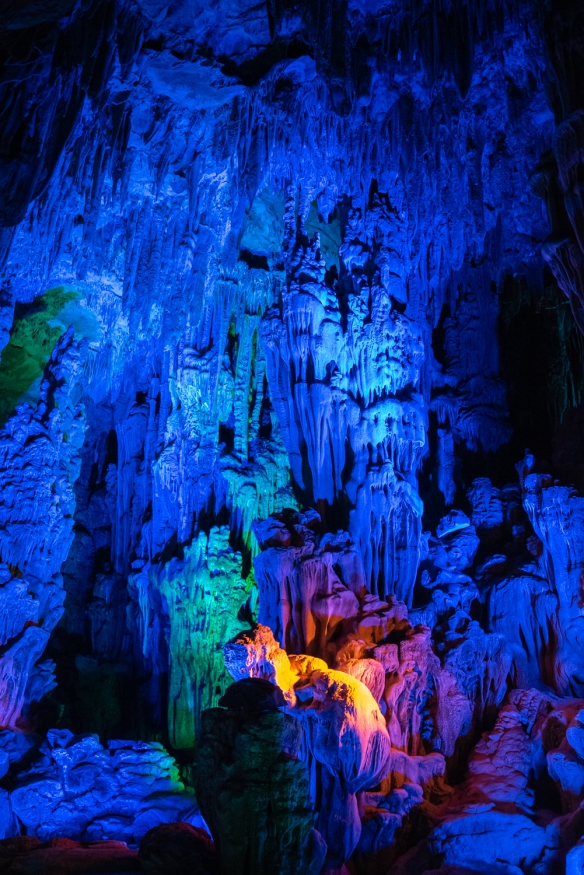
One of the first “rooms” that we walked through on our tour of Reed Flute Cave, a water-eroded cave that is a spectacular world of various stalactites, stone pillars and rock formations created by carbonate deposition, all illuminated by colored lighting; Guilin, Guangxi, China
“As a brilliant Karst cave marked on almost all travel itineraries, Reed Flute Cave got its name from the verdant reeds growing outside it, with which people make flutes. Actually, inside this water-eroded cave is a spectacular world of various stalactites, stone pillars and rock formations created by carbonate deposition. Illuminated by colored lighting, the fantastic spectacle is found in many variations. Walking through the serried stone pillars, tourists feast their eyes on changing spots, feeling they are in a paradise where the Gods live…
“Reed Flute Cave is formed by long-term water erosion and carbonate deposition. The rocks inside the cave are mainly limestone. When the underground water flows, it dissolves the calcium carbonate inside the limestone. When the water containing calcium carbonate flows out from underground or drops out from cave roof, the water evaporate, only leaving calcium carbonate. After years of accumulation, stalactites form. Till today, these stalactites inside the cave are still “growing” as the water keeps dropping or flowing.” — www.travelchinaguide.com/
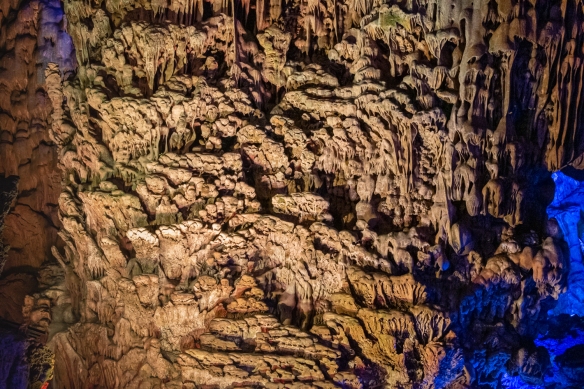
Reed Flute Cave, Guilin, Guangxi, China #2
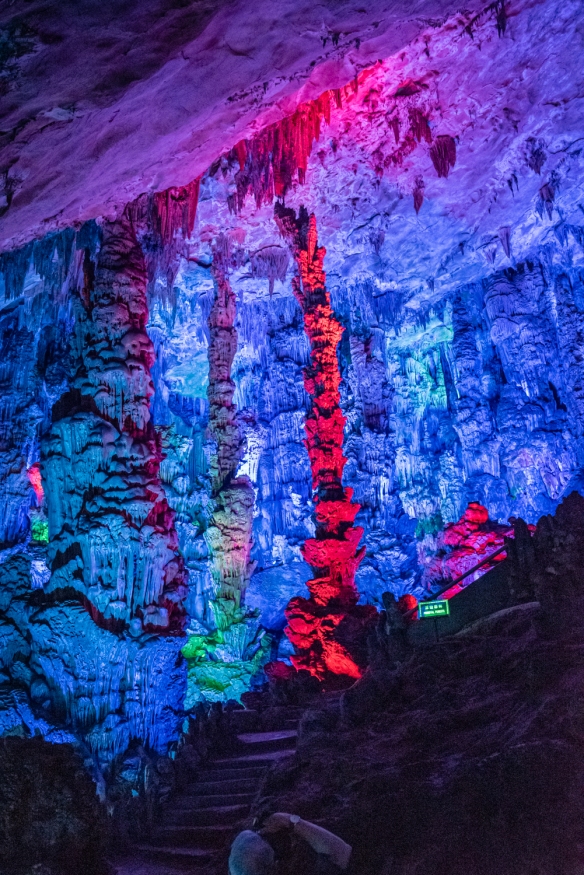
Reed Flute Cave, Guilin, Guangxi, China #3 – known as “Sky-Scraping Twin”, this formation resembles twin pillars in a forest
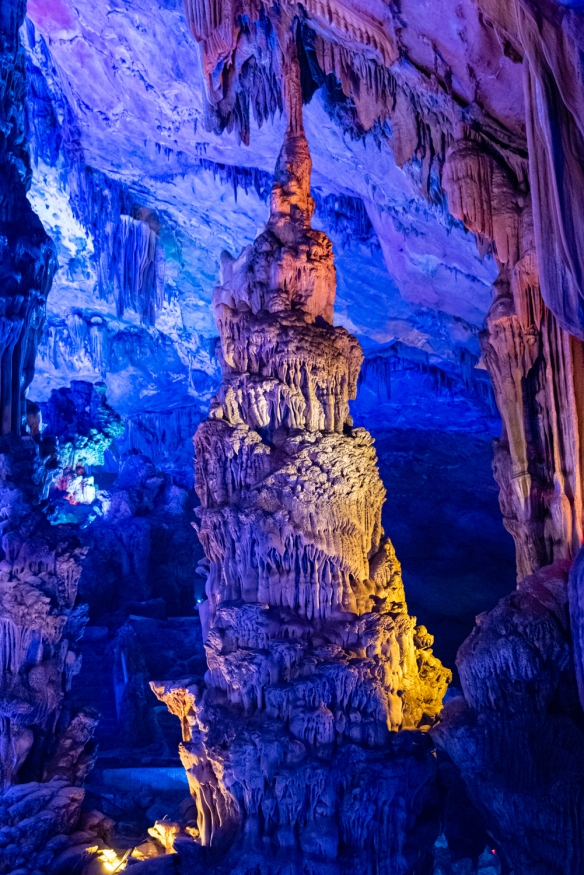
Reed Flute Cave, Guilin, Guangxi, China #4
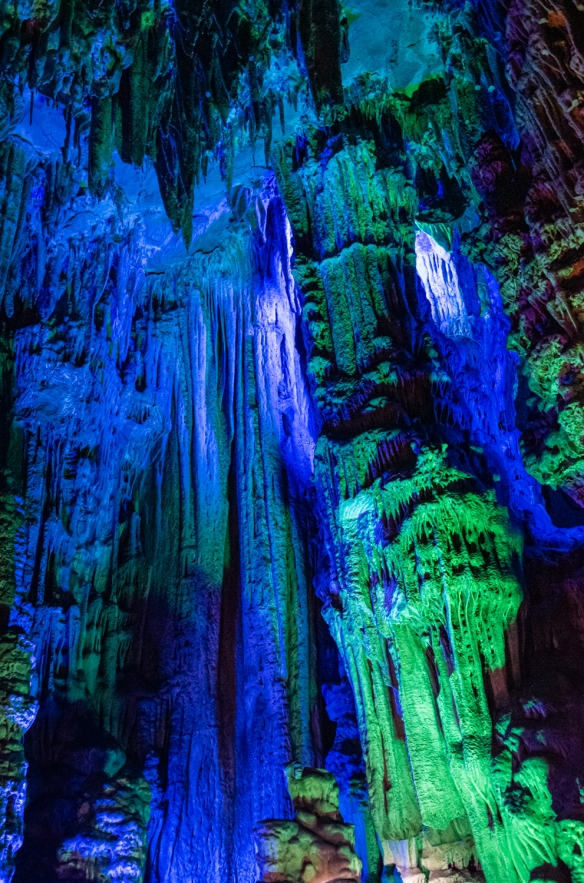
Reed Flute Cave, Guilin, Guangxi, China #5

Reed Flute Cave, Guilin, Guangxi, China #6

Reed Flute Cave, Guilin, Guangxi, China #7 — this large room is known as the “Crystal Palace”; a huge “Crystal Palace lamp” hangs on the upper left of the hall, painting the hall with a magical color, like the Dragon King’s Crystal Palace in the Chinese myth
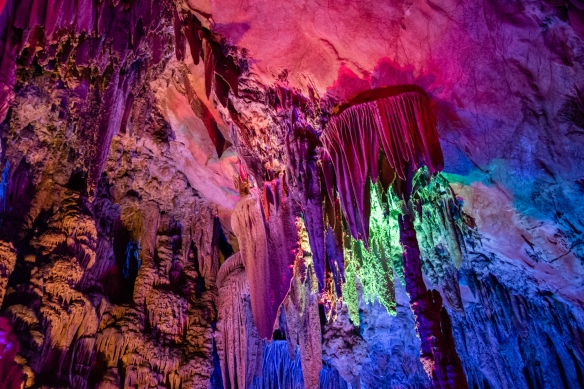
Reed Flute Cave, Guilin, Guangxi, China #8; the cave is also known as “the Palace of Natural Arts”
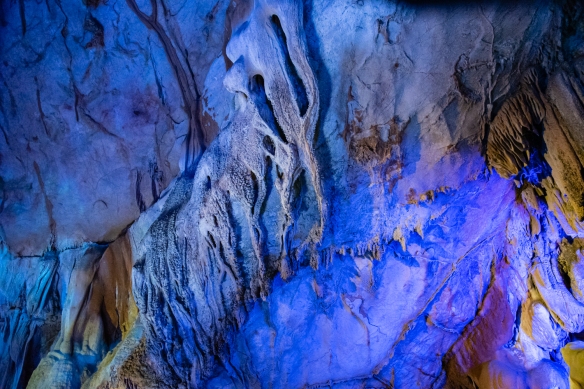
Reed Flute Cave, Guilin, Guangxi, China #9

Outside the entrance to Elephant Trunk Hill is a beautiful floral “sign” marking the 70th anniversary (October 1, 2019) of the Communists’ rise to power in China, which became the People’s Republic of China; we saw many such anniversary displays (mostly printed signs) all across China; Guilin, Guangxi, China
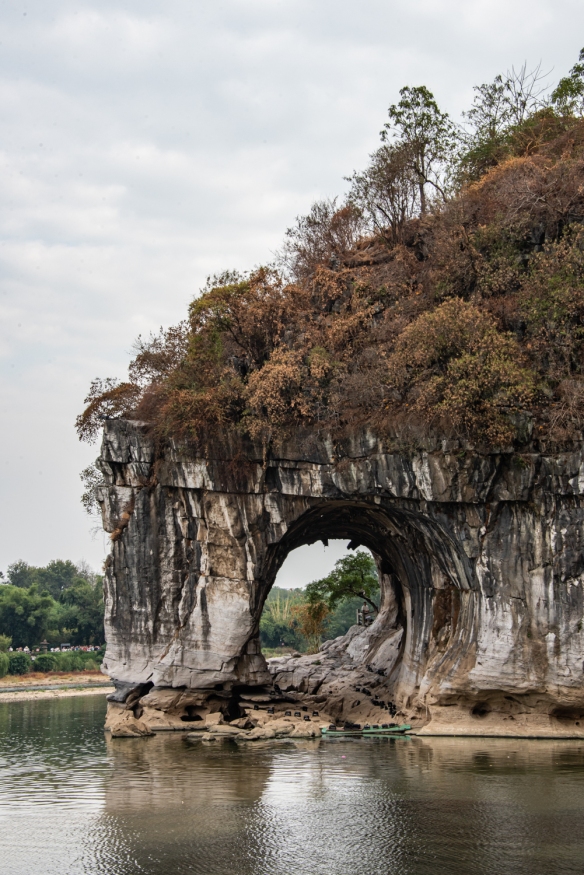
Elephant Trunk Hill (象鼻山; Xiàng bí shān) on Binjiang Rd (滨江路; Bīn jiānglù) is located on the banks of the Li River, within walking distance of Guilin’s city center; it is a hill with a large natural arch cut into it, resembling the trunk of an Elephant dipping into the river — this scene is frequently used as a symbol of the city and so has developed some fame; Guangxi, China
“Guangxi’s second-largest city, Guilin (桂林) has the hallmarks of most Chinese megapolises, but it feels much more relaxed given its spectacular setting among the jagged-peak limestone karsts that surround it. It was China’s first city to develop tourism after 1949, and for decades, children’s textbooks proclaimed ‘Guilin’s landscape is the best under heaven’ (桂林山水甲天下). It was the darling of Chinese politicians, the star city proudly presented to visiting dignitaries. Today Guilin’s natural endowments still amaze, yet, thanks to imperfect urban planning, there is a pervasive feeling that the city is past its prime.” — www.lonelyplanet.com
Legal Notices: All photographs copyright © 2019 by Richard C. Edwards. All Rights Reserved Worldwide. Permission to link to this blog post is granted for educational and non-commercial purposes only.

Amazing spectacles of nature.
LikeLike
We LOVED Guilin! Caves tour was interesting, even in German.
On Fri, Dec 13, 2019 at 5:35 PM Where in the world is Riccardo? wrote:
> richardcedwards posted: ” From the ship, a we joined a small group of > fellow Residents for a four-day overland trip to the south-central province > of Guangxi (located on the border of Vietnam), more properly called the > Guangxi Zhuang Autonomous Region. We had an early mo” >
LikeLike
These are awesome I love caves! i think its awesome this one has the blue lighting, so cool! thank you for sharing!
LikeLike
Rich, great fotos w a wonderful view of what most do not get to see,,,,,,,,,,,,j{P +++++++++++++++++++++++++++++
LikeLike
Been there! Kind of like a Disneyland version of caves. Did they tell you that bandits used to hide out in the caves?
LikeLike
Reblogged this on Echoes in the Mist.
LikeLike